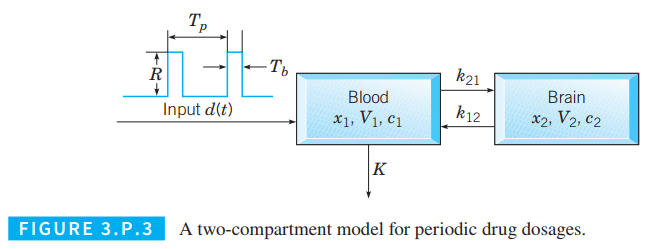
If
to show that

To prove:

and the mass balance law
Explanation of Solution
Given information:

Formula used:
Mass balance law
Proof:
Let the rate constant
Therefore, the input rate of the compartment
compartment
As
Therefore, the output rate of the drug from the compartment
compartment
By using mass balance law,
From the given figure, the input rate of the compartment
compartment
Also, the output rate of the drug from the compartment
compartment
By using mass balance law,
Therefore,
Want to see more full solutions like this?
Chapter 3 Solutions
DIFFERENTIAL EQUATIONS W/WILEYPLUS
Additional Math Textbook Solutions
Calculus for Business, Economics, Life Sciences, and Social Sciences (14th Edition)
Elementary Statistics: Picturing the World (7th Edition)
Pre-Algebra Student Edition
Elementary Statistics Using The Ti-83/84 Plus Calculator, Books A La Carte Edition (5th Edition)
College Algebra with Modeling & Visualization (5th Edition)
A Problem Solving Approach To Mathematics For Elementary School Teachers (13th Edition)
- AP1.2 A child is 40 inches tall, which places her at the 90th percentile of all children of similar age. The heights for children of this age form an approximately Normal distribution with a mean of 38 inches. Based on this information, what is the standard deviation of the heights of all children of this age? 0.20 inches (c) 0.65 inches (e) 1.56 inches 0.31 inches (d) 1.21 inchesarrow_forwardShow that is exist homomor Pick to Subspace Product. to plogy. Prove that Pen Projection map TTB: TTX XB is countiunals and open map but hot closed map.arrow_forwardAP1.1 You look at real estate ads for houses in Sarasota, Florida. Many houses range from $200,000 to $400,000 in price. The few houses on the water, however, have prices up to $15 million. Which of the following statements best describes the distribution of home prices in Sarasota? The distribution is most likely skewed to the left, and the mean is greater than the median. The distribution is most likely skewed to the left, and the mean is less than the median. The distribution is roughly symmetric with a few high outliers, and the mean is approximately equal to the median. The distribution is most likely skewed to the right, and the mean is greater than the median. The distribution is most likely skewed to the right, and the mean is less than the median.arrow_forward
- What is a? And b?arrow_forwardHow parents can assess children's learning at home and how the task can be differentiated. Must provide two examples of differentiation tasks. Mathematics in Practice Assignment 2arrow_forwardWhen ever one Point sets in X are closed a collection of functions which separates Points from closed set will separates Point. 18 (prod) is product topological space then xe A (xx, Tx) is homeomorphic to sub space of the Product space (TXA, prod). KeA The Bin Projection map 18: Tx XP is continuous and open but heed hot to be closed. Acale ctioneA} of continuos function ona topogical Space X se partes Points from closed sets inx iff the set (v) for KEA and Vopen set inx from a base for top on X-arrow_forward
- Why are Bartleby experts giving only chatgpt answers?? Why are you wasting our Money and time ?arrow_forward9. (a) Use pseudocode to describe an algo- rithm for determining the value of a game tree when both players follow a minmax strategy. (b) Suppose that T₁ and T2 are spanning trees of a simple graph G. Moreover, suppose that ₁ is an edge in T₁ that is not in T2. Show that there is an edge 2 in T2 that is not in T₁ such that T₁ remains a spanning tree if ₁ is removed from it and 2 is added to it, and T2 remains a spanning tree if 2 is removed from it and e₁ is added to it. (c) Show that a degree-constrained spanning tree of a simple graph in which each vertex has degree not exceeding 2 2 consists of a single Hamiltonian path in the graph.arrow_forwardChatgpt give wrong answer No chatgpt pls will upvotearrow_forward
- @when ever one Point sets in x are closed a collection of functions which separates Points from closed set will separates Point. 18 (prod) is product topological space then VaeA (xx, Tx) is homeomorphic to sul space of the Product space (Txa, prod). KeA © The Bin Projection map B: Tx XP is continuous and open but heed hot to be closed. A collection (SEA) of continuos function oha topolgical Space X se partes Points from closed sets inx iff the set (v) for KEA and Vopen set in Xx from a base for top on x.arrow_forwardNo chatgpt pls will upvotearrow_forwardThe roots of the equation -1÷2 and -3÷2 . Find the values a,b and carrow_forward
 College Algebra (MindTap Course List)AlgebraISBN:9781305652231Author:R. David Gustafson, Jeff HughesPublisher:Cengage LearningAlgebra & Trigonometry with Analytic GeometryAlgebraISBN:9781133382119Author:SwokowskiPublisher:Cengage
College Algebra (MindTap Course List)AlgebraISBN:9781305652231Author:R. David Gustafson, Jeff HughesPublisher:Cengage LearningAlgebra & Trigonometry with Analytic GeometryAlgebraISBN:9781133382119Author:SwokowskiPublisher:Cengage Linear Algebra: A Modern IntroductionAlgebraISBN:9781285463247Author:David PoolePublisher:Cengage Learning
Linear Algebra: A Modern IntroductionAlgebraISBN:9781285463247Author:David PoolePublisher:Cengage Learning


